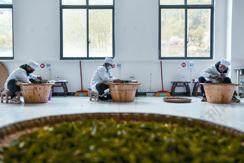A GOLD RIBBON FLOATS
2021-12-05

Workers lay copper tiles on a pavilion of the Fenghuangling Bridge in Liuzhou, Guangxi Zhuang Autonomous Region, on November 24. The construction of the bridge has entered its final sprint.
The bridge, including five pavilions across the Liujiang River, appears to be covered with gold, displaying a typical style of local architecture.
Towering Bridge
The main tower of Tongzi River Grand Bridge in Guizhou Province on November 21; the tower was capped that same day. The 1,422-meter-long bridge is an important part of the Jinsha-Renhuai-Tongzi Highway. The completion of this highway will significantly cut travel time between cities along the route and help promote their economy.

Regulating Entertainment
Chinas cyberspace regulator has issued a circular calling for an Internet-wide boycott of entertainers who have broken the law or transgressed social morality, reported Xinhua News Agency on November 23.
There will be no room for these entertainers to seek a comeback by circumventing restrictions, the Office of the Central Cyberspace Affairs Commission said in the circular.
Celebrity-related content promoting vulgar information or containing fake online reviews, unproven stories about entertainers or irrational acts of idol worship is prohibited on the Internet, the office said.
Content involving entertainers endorsing products, services, brands or for-profit events can only appear as clearly-marked advertisements on online platforms, the office said.
New Airport
A new civil airport in Shaoguan, Guangdong Province, opened its gates to passengers on November 27.
The new airport is located in Ruyuan Yao Autonomous County in Shaoguan. It is approximately 60 km from the Danxia Mountain, a nationally renowned scenic spot, and about 50 km from the Nanhua Temple, a famous Buddhist temple.
With a designed potential annual throughput of 2 million passengers, the airport is capable of handling 4,000 tons of cargo and mail every year. It is expected to see 9,500 airplanes take off and land annually.
The airport plans to launch air routes linking several major cities, including Beijing, Shanghai, Nanning, Hangzhou and Kunming.
Guangdong currently has nine civil airports, including the new Shaoguan airport.
Astronauts Honored
Three astronauts of the Shenzhou-12 spaceflight mission were awarded medals for their service to Chinas space endeavors on November 23.
Nie Haisheng, 56, commander of the Shenzhou-12 spacecraft, was honored with a first-class aerospace achievement medal; Liu Boming, 54, was conferred a second-class medal; and Tang Hongbo, 45, received a thirdclass medal and the honorary title of “heroic astronaut.”
The awards were given by the Communist Party of China Central Committee, the State Council and the Central Military Commission.
Launched on June 17, Shenzhou-12 sent astronauts to Chinas space station core module Tianhe for the first time. The astronauts then lived in the module for three months, the longest time Chinese astronauts have spent in space to date.
The Shenzhou-12 mission was the third space mission for Nie and his second deployment as commander. He is the first Chinese astronaut to spend 100 days in space. It was Lius second space mission and Tangs first.
The Shenzhou-12 mission is part of Chinas plan to build a permanent manned space station.
Rural Legal Talent
A set of pilot procedures on fostering legally savvy rural talent has been issued to advance the rule of law in rural areas, the Ministry of Justice announced on November 20.
The talent-building effort should be made to meet peoples legal needs and focus on addressing legal issues faced by rural people in their daily life, according to the newly released document.
The document said that the efforts should be integrated into the overall plan of building a rule-of-law society as well as the national rural revitalization strategy.
According to the document, the system for fostering individuals with adequate legal awareness and capabilities should be established by 2025, and each administrative village across the country should foster at least three such people by that time.
Side Jobs
A recent survey by China Youth Daily shows that 85.5 percent of young Chinese are willing to take up side jobs, Xinhua reported on November 21.
Of the 2,454 respondents aged 18 to 35, nearly 12 percent had already done a side job in addition to their full-time work.
Nearly 82 percent of the respondents said that more young people are taking up side jobs, with popular choices including online business, trying to become online celebrities, and selling online courses.
Among the people surveyed, 63.8 percent said that the ability to plan is vital to successfully taking on a side hustle.
Attitudes toward having side hustles vary among young people. About 72 percent believe that side jobs provide more opportunities, while 63.5 percent said that side hustles enrich spiritual life and offer a more colorful life outside of work.
Protecting Historical Sites
The Chinese Government has issued a Five-Year Plan to improve the protection, management and utilization of the countrys major historical sites, Xinhua reported on November 20.
According to the National Cultural Heritage Administration, the plan, designed for the 2021 to 2025 period, highlights the need to strengthen the archaeological study of major historical sites.
The government will promote major projects to explore the origins of Chinese civilization, support the formulation of medium and long-term archaeological work plans for key sites, and build a national platform for basic information and data on the sites.
Major historical sites in the plan mainly include settlements, palaces, tombs and other largescale historical and cultural landscapes with great value and far-reaching influence.
They usually reflect the different developmental stages of ancient Chinese history, such as the Old Summer Palace, the Archaeological Ruins of Liangzhu City, and the Grand Canal.
China has formed a conservation structure encompassing 150 major historical sites following the implementation of three five-year plans since 2006. A list of 36 national archaeological parks has been made public.
In Full Bloom
Villagers arrange chrysanthemums in Qianjia, a village in Hengyang City of Hunan Province, on November 23.

Neonatal Care
A neonatal critical care center has opened to the public in Ngari Prefecture, Tibet Autonomous Region, Xinhua reported on November 23.
With a total investment of 5 million yuan ($783,000), the center established in Ngari Prefecture Peoples Hospital is the first of its kind in the border region.
“Supplied with highfrequency oscillatory ventilation equipment, the center will be used for the treatment of acute respiratory distress syndrome, pulmonary hemorrhage and other refractory respiratory failures,” said hospital administrator Chen Nigari.
“The center will be effective in reducing the neonatal mortality rate in the region,” Chen added.
It was established through an aid program partnership between Shaanxi Province, Tibet and Beijing United Charity Foundation.
With an average altitude of more than 4,500 meters, development in Ngari is restricted by the harsh natural environment. It features relatively backward medical and health facilities and limited capabilities to treat critically ill newborns.
TEA MAKERS
Contestants make tea while participating in a vocational skills competition at a secondary vocational school in Longli County, Guizhou Province, on November 23.

Little Giant Firms
China has incubated 4,762 national-level “little giant”enterprises to date, according to the Ministry of Industry and Information Technology (MIIT) on November 23.
“Little giant” firms are small enterprises that are still in the early stage of development and focus on new-generation information technology, highend equipment manufacturing, new energy, new materials, biomedicine and other high-end fields.
The operating incomes and total profits of “little giant” enterprises increased 31.6 percent and 67.9 percent, respectively, in the first nine months of this year, Xu Xiaolan, Vice Minister of the MIIT, told a news briefing.
These enterprises have strong innovation capacities and developmental resilience, Xu said, adding that the majority of them are operating in basic industrial fields and have invested more than 10 million yuan ($1.56 million) in research and development.
By the end of October this year, more than 70 percent of such enterprises were able to obtain loans, with their average loan balance totaling 75.26 million yuan ($11.7 million).
Green Investment
Further green investment is on the horizon for China as the country gradually shifts toward a more institutionalized phase of decarbonization, according to a research report by multinational financial services firm Morgan Stanley, cited by Xinhua News Agency on November 23.
“We expect policymakers to step up support for green investments from 2022, such as renewables, smart grid, power storage equipment, and manufacturing equipment upgrades,” said Robin Xing, Morgan Stanleys chief China economist, in the co-authored report.
The green push is expected to inject new impetus into the Chinese economy. The investment bank forecast a recovery in infrastructure driven by green investment, saying it expects infrastructure investment growth to rebound to 4 percent next year.
Manufacturing investment demand is also predicted to rise as manufacturers upgrade their equipment to improve energy efficiency, according to the report.
The projections came amid Chinas continuous efforts to decarbonize to fight for blue skies and mitigate the impacts of climate change.
China in October unveiled an overarching set of guidelines for achieving its carbon peak and carbon neutrality goals, as well as an action plan to peak carbon dioxide emissions before 2030.
Civil Aviation
Chinas civil aviation authorities will introduce comprehensive measures to facilitate further recovery of the industry.
The Civil Aviation Administration of China (CAAC) said it will strive to boost the sustainable and stable recovery of the sector with a key focus on COVID-19 prevention and control and the industrys safe operation.
Chinas civil aviation sector has remained the worlds second largest in terms of passenger trips for 15 years.
Thanks to the countrys economic resilience and effective epidemic control, China leads the global civil aviation industry in recovery from the impact of COVID-19.
As of late October, the industrys major indicators, including total air transport turnover, passenger numbers and freight volume, had reached 69.9 percent, 66.4 percent and 80.5 percent, respectively, of the annual target set by the CAAC.
Despite the largely stable performance, Chinas civil aviation industry has experienced significant fluctuations due to both the domestic and international effects of COVID-19. The industrys continuous recovery still faces challenges, said the CAAC.
In order to further boost market vitality, the CAAC is encouraging airlines, airports and other industry operators to introduce differentiated and tailored service products to meet the diverse demands of customers.
Securities Revenue
Chinas 140 securities brokers saw their operating revenues reach 366.36 billion yuan ($57.4 billion) in the first three quarters of 2021, according to the Securities Association of China.
In breakdown, revenues from securities trading came in at 100.08 billion yuan ($15.6 billion), while that of securities underwriting and sponsoring business, and asset management stood at 41.6 billion yuan($6.5 billion) and 21.96 billion yuan ($3.4 billion), respectively, during the period, the association said.
The net profits of the securities companies totaled 143.98 billion yuan ($22.5 billion) in the first nine months, according to the association.
By the end of September, the total assets of the securities brokers reached 10.31 trillion yuan ($1.6 trillion), with net assets standing at 2.49 trillion yuan($389.6 billion).
The net capital of these securities companies totaled 1.94 trillion yuan ($303.6 billion), according to the association.
Fiscal Revenue
Chinas fiscal revenue logged a year-on-year increase of 14.5 percent in the first 10 months of the year, according to official data released on November 19.
The countrys fiscal revenue amounted to 18.15 trillion yuan($2.8 trillion) during the period, according to data from the Ministry of Finance.
Tax revenue came in at 15.65 trillion yuan ($2.4 trillion) in the January-October period, up 15.9 percent year on year.
Revenue from value-added tax, the largest source of fiscal revenue in the country, jumped 15.1 percent from a year earlier to 5.54 trillion yuan ($867 billion).
The Central Government and local governments collected 8.47 trillion yuan ($1.32 trillion) and 9.69 trillion yuan ($1.51 trillion) in fiscal revenue, up 15 percent and 14.1 percent, respectively.
The data also showed that Chinas fiscal spending increased 2.4 percent year on year to 19.4 trillion yuan ($3 trillion) in the first 10 months.
Fiscal spending on education rose 4.8 percent year on year, while health and medical care spending grew by 2.3 percent, the ministry said.
Legoland Resort
Construction of the Legoland Shanghai Resort kicked off on November 17, with the resort expected to open in 2024, according to local authorities.
Covering an area of 318,000 square meters, the resort is located in the Jinshan District of southwestern Shanghai.
The facility will include eight themed areas covering most of the signature and popular attractions and rides of Legoland Parks around the world.
The resort will also integrate local cultural elements such as setting up a Monkey Kingthemed zone that references traditional Chinese architectural styles and natural landscapes.
With an investment of $550 million, the resort is funded by several parties, including Chinas state-owned enterprises.
“The LEGO brand has increased its presence in and contributions to China over the past few years,” said Jorgen Vig Knudstorp, Executive Chairman of the LEGO Brand Group. “We are thrilled with the positive response the LEGO brand has received in China,” he added.
NUMBERS


